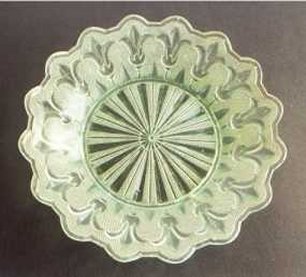|
Sugar water sets
 The small carafe is part of a set which
consists of five pieces: The small carafe is part of a set which
consists of five pieces:
- a larger water carafe
- a small carafe
- a footed goblet
- a covered sugar, and
- a plate.
There are two more sets on page 15, and all in all 12 more on pages 23 to 25, 48, 51, 59
and 77, each in a different decoration. The name for the sets is "verres d'eau".
Once I had become aware of the arrangement I found more in later catalogues. The 1893
Baccarat catalogue shows the same arrangement of five pieces, but the price list next to the drawings has six pieces, the sixth being a second goblet. The name for the set is "Verre
d'eau six pièces" and it cost 8.40 francs with a round plate, 9.35 when the plate was square. More examples were to be found in the Val St. Lambert
catalogues of 1908 and 1913. And as late as 1933, Portieux listed no less than 45 sets on pp. 68-75 in their catalogue. All these sets consisted of 6 pieces and
were always named "Verre d'eau six pièces".
At first, the composition of the sets seemed strange to me. I was familiar with all sorts of sets
with plates - beer sets, liqueur sets, and, most of all, the ubiquitous German sugar and creamer set. But I had never come across - so I thought - a combination of carafes and sugar
bowls. Accidentally I found out that this seemingly French custom wasn't so French at all, at least not some two hundred years ago.
In its exhibition of silver sugar bowls, the Berlin Sugar Museum has a "Zuckerwasser Garnitur
" (sugar water set) on display which consists of a richly decorated silver plate, a glass carafe, a goblet with a silver cover, a footed sugar bowl and a sugar spoon. The set is
Viennese and an inscription says that it was given as a present in 1836.
In an essay dealing with this rare exhibit (only three other complete sets are known) the
former director of the museum, H. Olbrich, throws some light on its cultural background. Sugar water was a popular refreshment from the 17th to the 19th centuries in Europe. As sugar was
quite expensive not many could afford this beverage and, accordingly, the utensils necessary for this habit were luxurious and displayed the wealth of its owners. Glass producers, glass
refiners and silversmiths were eager to provide the "water sets" or "sugar water sets". In the
second half of the 19th century sugar became cheaper, and the sets were now available also in pressed glass.
The small carafe (in the Launay Hautin catalogue "carafe à fleur d'orange", in later catalogues
"fleur d'oranger") was designated for a liquid to refine the taste of pure sugar water. Bohemian
catalogues and price lists suggested "rhum" or "rosewater". The French seem to have preferred
essence of orange flowers. Sugar water with fleur d'oranger was Napoleon Bonaparte's favourite beverage throughout his life, and he demanded it just before he died, as his last
doctor on St. Helena, C. F. Antommarchi reported. The glassmakers in Portieux may have intended to perpetuate the habit well into the 20th century: the first three sets on page 68 of
the 1933 catalogue were miniature sets for the nursery ("jouet").
Hubert Olbrich, "Zuckerwasser- Garnituren", Katalog des Zuckermuseums Berlin (Berlin, 1991),
pp. 168-169.
|